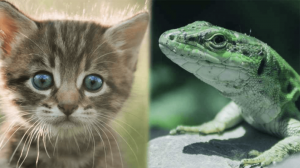Have you ever wondered what difference is between endotherms and ectotherms?In general, if an organism uses energy to regulate its body temperature internally, then it is considered endothermic. If an organism instead relies on external environmental factors to regulate its body temperature, then it is considered ectothermic. There are pros and cons to each of these methods of regulating body temperature.
To be endothermic, an organism must produce its own body heat through metabolism. This means that the endothermic organism can maintain internal homeostasis regardless of the external environmental temperature. This ability is commonly referred to as being warm-blooded and probably sounds familiar because of the fact that mammals are warm-blooded, thus making us endotherms. An example is seen in the image below, the young kitten. This is why during winter or summer temperatures, humans will maintain an internal body temperature of around 98.6 degrees Fahrenheit.
Once we understand that we are endotherms, we can then understand better why we sweat or shiver when we are hot or cold. These actions are regulatory reactions from our body trying to maintain internal homeostasis while being exposed to differing external temperatures. The sweat we produce during hot days is actually helping to cool our bodies down and we shiver during cold days to keep our bodies warm. Being an endotherm allows an organism to survive in many diverse environments, but can be extremely energy demanding.
On the other hand, an organism that relies on the temperature of the environment around them to regulate their internal body temperature requires much less energy. This type of organism is called an ectotherm and commonly referred to as being cold-blooded. Great examples of ectothermic organisms are reptiles and fish. In the image below an example reptile is shown. Since these organisms rely on the environment for body temperature regulations, they exhibit different behaviors in reaction to changing external temperatures. In order for an ectotherm to warm up it would bask in the sun, or if it needed to cool down it could burrow or seek shade. These are physical interactions with the environment since the ectothermic organism can not rely on physiological processes like the endotherm (such as sweating and shivering).

So depending on if an organism is and endotherm or ectotherm, it will exhibit varying behaviors in order to survive and function at optimal level in their environment. Some examples are:
-Fish migrating to warmer/colder water as needed during season changes.
-Lizards coming out of burrows to bask in the sun in order to warm their bodies.
-Humans shivering during a cold night hike.
-Sea lions holding their flipper out of the cold ocean water to warm up.
Hopefully this has helped to clarify the main difference between endotherms and ectotherms. There is much more to be learned about these organisms and I hope this information helps encourage you to learn more about them.
Written By: Ryan McDuff


